With forethought, you can be successful in avoiding winter injuries on the homestead. The unique hazards of winter like ice, mud, snow, wind and unpredictable livestock, can be dangerous. Understanding the dangers can help you avoid winter injuries.
Avoid falls
When you live in the city, you can still fall on icy sidewalks and parking lots, but it’s someone else’s job to keep them clear of accumulated snow and ice. However, in the country, it’s your job.
Salting the sidewalks works if your area stays around 0C, but if temperatures drop consistently below -10C you’d better find another alternative because salted melted ice will refreeze to a slick skating rink in low temperatures, increasing the danger.
On the homestead, wood ashes work well to break up icy surfaces and add traction to walkways, roadways and parking areas. If you have a bucket of gravel handy, throw down a bit on super slick areas, after the snowfall to maintain traction on hills and dips in the walkway.
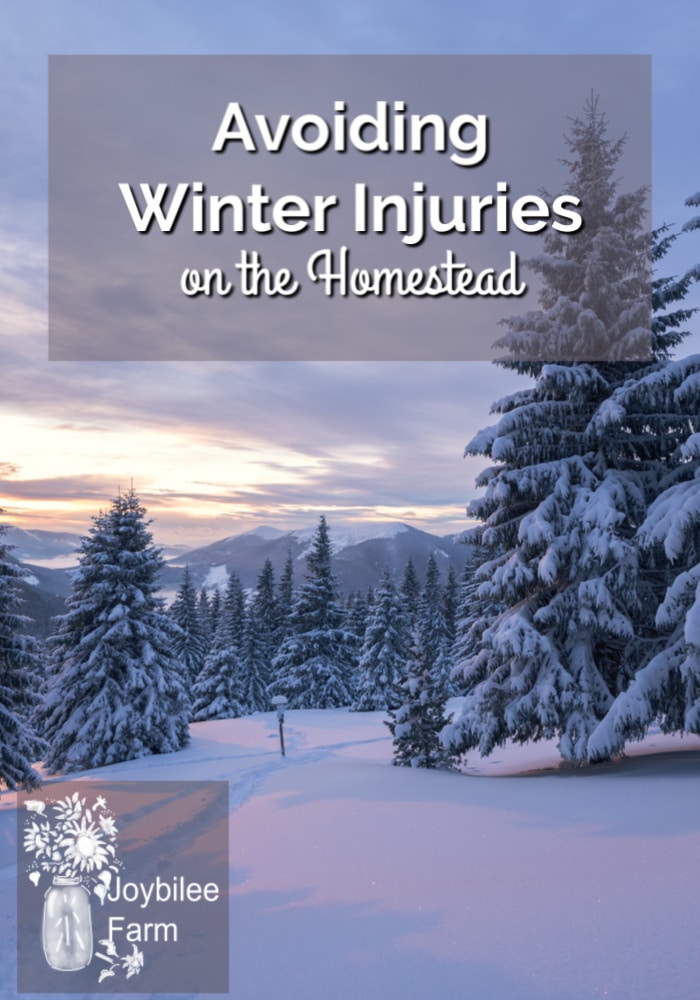
Wear the Right Boots
Wear proper boots outside in snowy, icy weather. Running shoes, wooden clogs, and gumboots all have soles that get incredibly slick on ice. I’ve seen homesteaders wear them outside in winter. Be smart, don’t take a chance on a dangerous fall by slipping on a quick pair of summer boots to run out to the barn (pun intended). Instead, get a pair of boots rated for winter use on ice.
Bogs Boots have very good traction and this is what Robin and Sarah wear to prevent slipping at Joybilee Farm. Muck winter boots, also have good traction and arch reinforcement. Robin thought that our trails were too icy and mud boots would be a waste of money. Now that he’s tried them for a couple of years, he agrees that they are worth the investment.
Using ice grippers? Do they work?
One way of avoiding winter injuries on the homestead is by using ice gripper attachments to your boots. We tried these and they tend to break with heavy use. The cheaper ones made with stretchy elastic and coiled wires tend to slip off when they get weighted with snow. Then you find yourself walking back to look for where they dropped in the pathway.
The other kind of boot attachments that strap over your boots stays on reliably but the metal treads get coated in icy manure and muck in the barns and then lose their effectiveness. If you only need them to walk to the greenhouse or the stock water-er and aren’t going through a mucky area with them on, they work.
A traditional way to give traction in the snow is to use heavy woollen over-shoes on your boots. These need to be made and felted over your boots for the best results. They keep your feet insulated and are nonslippery when new. If the bottoms get covered in grease or manure though, they will need to be washed to maintain their slip-free bottoms. If you have lots of wool, though, they are worth trying out.
Beware of frostbite
Another real danger in winter on the homestead is frostbite. Frostbite happens when the temperature combined with the wind chill feels cold and exposed skin, fingers, and toes lose their body heat and begin to freeze. It’s easier to prevent frostbite than to heal it.
Wear wool
Damp mittens, gloves, scarves, and socks draw warmth away from your body, chilling you and leaving you at risk for frostbite. But wool clothes, socks and gloves continue to insulate even when wet. Mohair, angora, silk, cashmere, buffalo down and yak down, which are all animal fibres, also share this trait with wool. But, manmade fibres that mimic the feel of wool, are worthless to keep you warm in dangerous icy winter conditions.
If you find wool mittens or gloves difficult to find you can make your own with this upcycled sweater pattern or this knitting pattern.

Avoiding winter injuries on the homestead by listening to the Weather Report
Don’t go outside with exposed skin when the temperature plus wind chill factor drops the temperature to -40C. Exposed skin can freeze in 5 minutes at this temperature. Check out this article from Environment Canada to calculate the windchill at various temperatures and prepare adequately to mitigate the risk when you need to go outside.
When temperatures are really cold, it’s best to stay home. Even a quick trip in the car can lead to an emergency when it’s really cold; gas lines freeze, batteries are unreliable and a quick road trip can turn nasty fast. Wait until the temperature warms up before venturing out and you will stay safe.
Body areas most likely to frostbite include the nose, ears, fingers, and toes. Frostbite looks and reacts like a burn, damaging the skin surface and going deeper into the tissue as the cold progresses.
If you suspect frostbite, check for the signs and take action fast
Frost nipped fingers can be warmed by simply placing them under your armpits. Deeper frostbite requires emergency care.
The sooner you can thaw the skin or digits and restore circulation the better the chance of complete healing. However, don’t thaw frostbitten skin if there is a chance that the area will be refrozen. It is better to wait until you can get help.
5 Common Cold Weather Mistakes You Can Avoid, Even If You Live In the Great White North
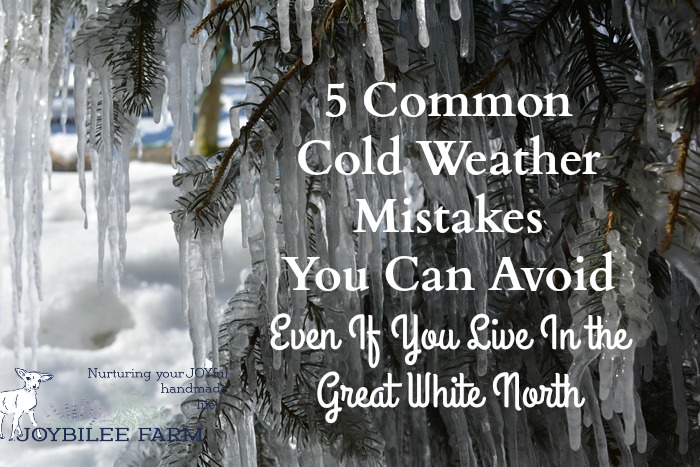
Signs of frostbite:
Frostbite looks like a burn. Tissues deep in the skin fill with ice crystals as the tissue freezes. There is a whitening of the skin surface. Early signs of frostbite are a numb, pale patch of skin, or skin that feels hard or looks waxy. The longer the skin is exposed the deeper the damage.
Treatment of frostbite:
Again: Don’t try to thaw frostbite if there is a danger that the frostbitten area could be re-frozen. Thawing and refreezing will cause the damage to go deeper into the tissue.
Don’t massage or rub deeply frostbitten tissues, you will increase the damage in the tissues. Any tissue that has only been lightly damaged can be thawed by placing it against the skin, under an armpit, for instance.
Don’t rub frostbitten skin with snow to thaw it, an old folk remedy. Instead, fill a bucket or bowl with warm water (100 to 105F) and immerse the frostbitten hand or foot. Refresh the water as it becomes cold. It takes about 30 minutes to thaw hands or feet. Then take the victim to the hospital emergency for treatment.
The Mayo Clinic has an excellent illustrated description of frostbite that will help you recognize it when you see it, along with step-by-step instructions to help your loved one while waiting for medical help.
Hypothermia
Hypothermia happens when the body temperature drops below normal. Hypothermia can be prevented by dressing appropriately for the weather, wearing woollen hats, mittens, scarves, socks and winter coats, and staying dry when the weather is inclement. Since wool continues to insulate, even when wet, wool or other animal fibres are the perfect protection for outdoor play and work.
If you get wet, your body temperature begins to drop, as the water evaporates from your wet clothing. Falling through the ice, playing in wet snow, being out in a freezing wind or blowing snow, can all contribute to hypothermia.
When the body temperature drops below normal a person begins to shiver. Blood is drawn away from the limbs and concentrated on the brain, and torso to keep vital organs working and keep the person alive. A person who is hypothermic at first knows they are cold, but after a while, as the heart slows down and the blood flow slows, they stop shivering and then calm takes over. They stop thinking logically, become confused and sleepy.
This is a very dangerous time. Don’t let them go to sleep while still hypothermic. If you can’t get them warm, then keep them walking and moving to keep the blood flowing to their brain, and their limbs. If possible remove wet clothing and wrap them in a prewarmed wool blanket. Get them to a warm fire.
Important
If they are already cold, wrapping them in a cold wool blanket will not help because they need their own body heat to warm up the wool before it can insulate them. They will need an outside source of heat; a warm human body, a hot bath, a candle, a fire or a heater. Once their body temperature is closer to normal, their own vital functions will maintain the temperature if you can wrap them in wool.
One often overlooked source of heat is food. Usually, emergency rations consist of sugary rich, carbohydrate calories. Emergency rations should be rich in coconut oil, too, to give quick energy that the body can convert immediately to heat. Once a person has gone beyond shivering, offering them warm drinks like tea with honey, or hot chocolate will be more effective than sugary foods.
If your loved one has regressed beyond mild hypothermia get medical help immediately.
Avoiding winter injuries associated with wood management
Most of the serious winter injuries that we’ve endured at Joybilee Farm have come through our wood management. Even transporting wood from the woodshed to the house in a wheelbarrow can be dangerous over icy paths. One time Robin was moving a wheelbarrow full of wood to the house, slipped on the ice and crashed down on the handle of the wheelbarrow. The wheelbarrow, being weighted with a couple of hundred pounds of wood, did not give way, but Robin’s ribs did. Ouch!
Other wood management injuries include:
- Slipping while you are swinging the maul to split the wood
- Wood flying from the chopping block and falling on your toes
- Wearing protective clothing helps to prevent some of these injuries.
Don’t chop wood when you are tired. That’s when misjudgement happens and accidental injuries often follow.
If you misjudge the amount of wood you need for winter and are out chopping down standing dead timber in February, use more caution than in summer. Falling trees in winter also bring falling snow. Your footing is less sure and chain saws can be more unpredictable when you start them up in very cold weather. Put on your chaps, face shield, and gloves before you start and use extra caution.
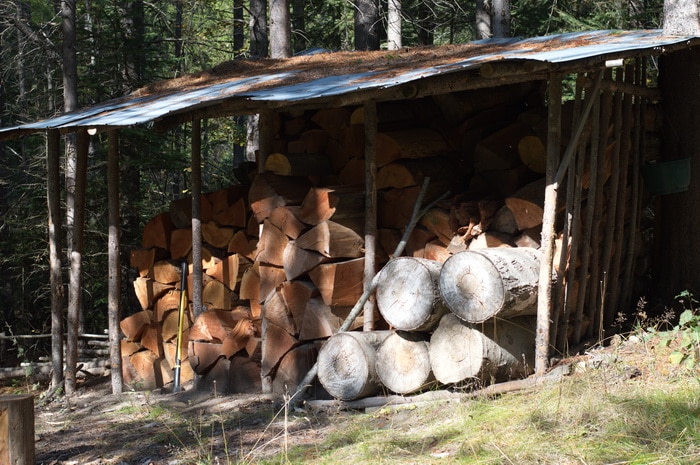
Injuries associated with male animals
Finally, since late Fall and early winter comes during the breeding season for many small ruminants, use extra caution around intact male animals. Bottle babies especially can be dangerous to people. They don’t differentiate between you and their own species and see you as a rival if you are male, or as a potential mate if you are female.
Decide now, never to leave a male bottle baby intact, for breeding. Castration will allow him to have a long and fruitful life as a fibre pet, and it will save you from having to cull him after he injures someone.
Male animals that you intend to keep for breeding shouldn’t be made the family pet. Keep children from teasing them or playing with them. Allow them to keep their distance from you, which is their instinct, but do halter break them so that they are easier to manage for hoof trimming, shearing, and doctoring. Take the middle road, and you’ll both be happier.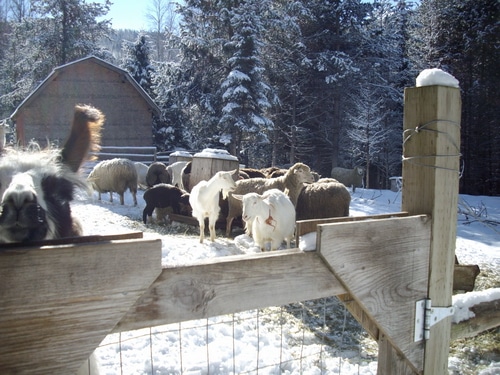
During the breeding season, male animals can be unpredictable and dangerous. Never turn your back in the barnyard. The full head charge of a breeding ram into your lower back or thighs causes a lot of pain and even serious injury. Small children in the pen can be trampled and injured.
Further, horned buck-goats fight by hooking their horns into their rival’s leg and twisting up, to break the leg. They’ll try this on you, too, if they see you as a rival.
Never enter the pen where there are a breeding male and his females during rutting season unless you take a long staff. Male animals respect the stick and will leave you alone. Don’t be afraid to prod an animal with the stick if they are threatening you. We teach our males to respect the stick when they are young and have never had a problem.

Dealing with Larger Animals on the Homestead
Other precautions are necessary when dealing with an animal larger than a goat or sheep. Electric prods can protect you if the animal is trained to it. One of the best precautions is to avoid making pets of your male stock. And always carry a strong staff when you enter a pen where there is an intact male.
Robin had an encounter with a young male yak when he was taking care of a neighbour’s place, while they were on vacation. To collect eggs, Robin had to enter the pen where the yaks were, past their electric fence, which wasn’t turned on. The yaks, a female with her 18-month-old son, were curious and came to where Robin was entering the chicken yard at the West end of their paddock.
When he came out of the chicken yard with his full bucket of eggs, and back into their pen, he startled the yak, who had his back turned. The yak’s response was to spin around facing Robin, lower that sharply horned head, and paw the ground, intending to charge Robin with his bucket full of eggs.
Oh-my! Robin didn’t have a stick. So he stood up tall and spoke with a strong, confident voice: “Whoa. Don’t do that, Boy.” Thankfully, the yak changed his mind, shook his head, and danced away, twisting and shaking himself. Both the yak and Robin were frightened by the encounter.
Invest in a first aid course
Winter brings unique risks to the homestead. Taking a few precautions can ensure that you get through winter with little mishap. I highly recommend that you and your partner take a first aid course together and keep your certificates up to date so that you feel confident when dealing with injuries. A first aid course will help you deal with veterinary emergencies, too.
Keep an up to date First Aid Kit on your homestead, in the house, in the shop, and your vehicle. When emergencies happen on the homestead, you are the first responder. 911 is the second responder.
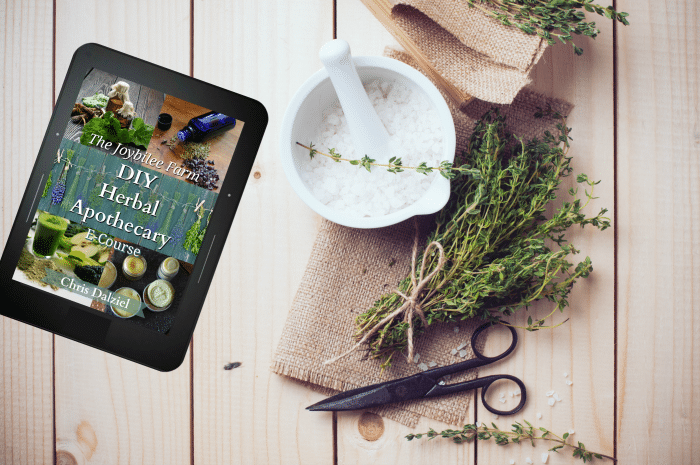
Herbal First Aid
When accidents do happen we, like many homesteaders, turn to an herbal apothecary as our primary first aid care. Often using an herbal remedy immediately when an injury happens can make a big difference in the time it takes to heal. Check out my DIY Herbal Apothecary Course to learn more about building your own DIY Herbal Apothecary for first aid and prevention.
Your turn:
Share your winter tips with our readers. Leave a comment below.


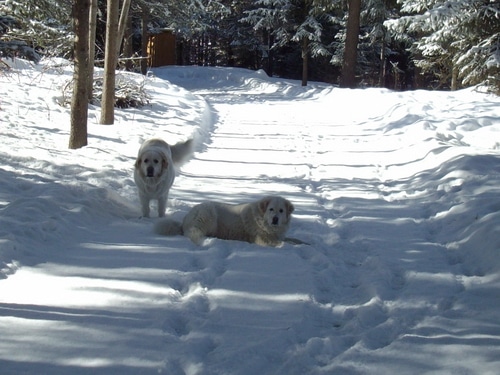

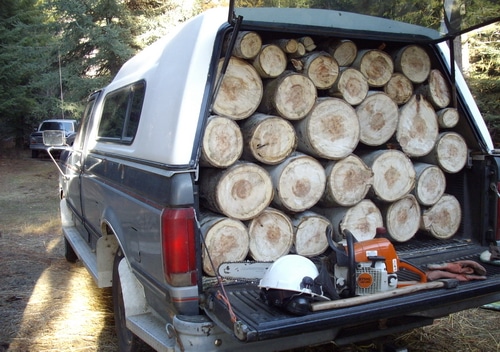

If infroamtion were soccer, this would be a goooooal!
Good point, Lorie. Those roof lines can be really sneaky. The snow on our roof makes enough noise before it hits the ground that the animals run for cover. Never had a chicken creamed by the falling snow. But we almost put our internet satellite dish right in line with the drip line. Just before the technician was going to leave, after measuring everything out, I remembered the snowfall danger and they moved the installation. Thank Goodness. ☺
I think Eholt is just a wee bit colder than Greenwood, but we definitely get more snow. Thanks for commenting, Ien. ☺
We love our Bogs! We wear them almost all year ( I would wear them through the summer if they weren’t so well insulated!) I also always use ice grippers on all my winter footwear- although the felted wool overshoes sound intriguing. I may have to try making a pair.
Instead of wheelbarrows, in the winter we use those big black sleds- one bale of hay fits in perfectly and there is no danger of tipping over!
The one thing I always forget at the beginning of winter is to stay clear of the roof lines- we have steeply pitched, metal roofs to shed snow and they don’t really care if you are standing under them when they let loose!.
Thanks for sharing this great article with us!
Great tips! I know how cold Greenwood gets, I can only imagine Eholt. That’s where you are, right?